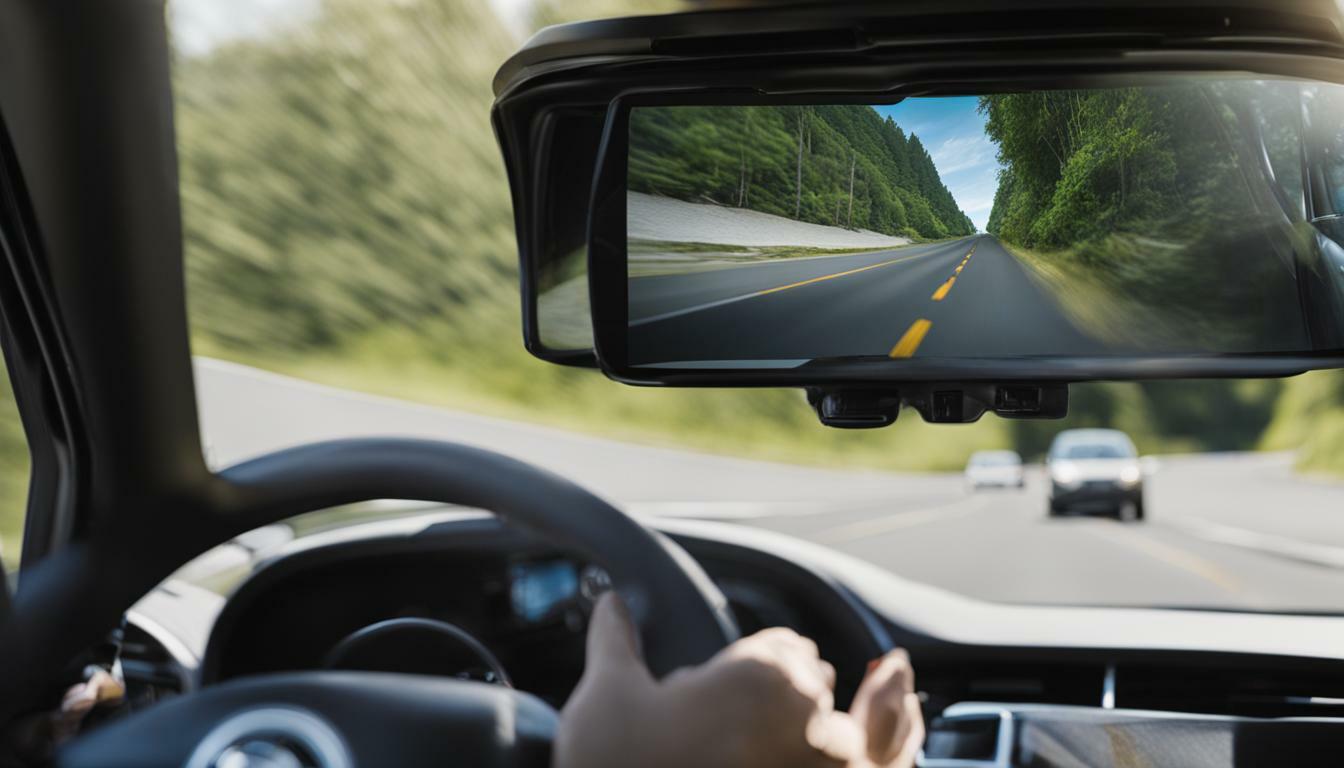Driving in Reverse
Driving in reverse requires specific techniques and precautions to ensure safe and efficient maneuvering. As a driver, it is important to understand the steps involved in driving in reverse and to practice them to become proficient in this skill. In this section, I will cover the basics of driving in reverse and provide helpful tips for mastering this skill.
Key Takeaways:
- Conduct a 360-degree check around your vehicle before reversing to ensure there are no obstacles.
- Place your right foot on the brake pedal and your left hand on the top middle of the steering wheel.
- Shift the vehicle into reverse using the appropriate method for your transmission.
- Look out the back of the car over your passenger-side shoulder or rely on side mirrors if your view is obstructed.
- Gradually ease off the brake pedal to begin moving in reverse.
By following these techniques and practicing regularly, you can become more confident and skilled in driving in reverse. In the next sections, we will delve deeper into the different techniques, step-by-step instructions, and safety tips to enhance your reverse driving abilities. Let's get started!
Reverse Driving Techniques
To drive in reverse effectively, it's important to understand and practice proper techniques for maneuvering your vehicle backward. Whether you're parking, navigating tight spaces, or simply reversing out of a driveway, employing the right techniques will ensure a smooth and safe experience. Here are some key tips to help you master reverse driving:
- Conduct a thorough 360-degree check: Before you start reversing, visually scan the area around your vehicle to check for any obstacles or pedestrians. Use your mirrors and physically turn your head to get a complete view.
- Position your body correctly: Place your left hand on the top middle of the steering wheel and your right foot on the brake pedal. This positioning will give you better control and stability while reversing.
- Use the right method to shift into reverse: Depending on your vehicle's transmission, engage the appropriate method to shift into reverse gear. Follow the manufacturer's instructions for your specific vehicle.
- Maintain good visibility: Look out the back of the car over your passenger-side shoulder to have a clear view of the path behind you. If your view is obstructed, rely on your side mirrors to monitor your surroundings.
- Gradually ease off the brake pedal: Once you've checked for clearance, slowly release the brake pedal to start moving backward. This gentle acceleration will help you maintain control and avoid any sudden movements.
- Steer with caution: Use the steering wheel to turn the car in the desired direction. Remember to check the front end of your vehicle for clearance. For sharper turns, it's recommended to use both hands on the steering wheel.
- Control your speed: If necessary, transition your right foot to the gas pedal to control your reverse speed. Remember to drive slowly and be prepared to stop when needed.
- Stop safely: When you're finished reversing, firmly press the brake pedal to bring the vehicle to a complete stop. Shift back into park or engage the parking brake to secure your vehicle.
It's important to adjust your seat, mirrors, and seat belt before starting to reverse. Proper positioning will enhance your visibility and ensure your safety. Practice these techniques in different scenarios to build confidence and improve your reverse driving skills. Remember, the more you practice, the better you'll become at maneuvering your vehicle in reverse.
| Key Tips for Reverse Driving Techniques | Benefits |
|---|---|
| Conduct a thorough 360-degree check | Ensures no obstacles or pedestrians are in your way |
| Position your body correctly | Provides better control and stability |
| Use the right method to shift into reverse | Prevents accidental engagement of other gears |
| Maintain good visibility | Allows you to see potential hazards |
| Gradually ease off the brake pedal | Enables smoother acceleration and control |
| Steer with caution | Helps navigate the vehicle safely |
| Control your speed | Prevents sudden or excessive acceleration |
| Stop safely | Brings the vehicle to a complete stop without incidents |
How to Drive in Reverse
Learning how to drive in reverse requires following a specific set of instructions to ensure a smooth and controlled backwards movement. Focusing on safety and precision is essential to avoid accidents and damage to your vehicle. Here are the step-by-step instructions to help you navigate in reverse:
- Conduct a 360-degree check: Before you begin reversing, make sure to inspect your surroundings by actively looking around your vehicle. Pay attention to any obstacles or hazards that may impede your path.
- Positioning and controls: Place your right foot on the brake pedal and position your left hand on the top middle of the steering wheel. This grip allows for better control and maneuverability.
- Engage reverse gear: Depending on your vehicle's transmission, shift into the appropriate gear for reverse. Ensure that you fully engage the gear before proceeding.
- Check your line of sight: Look out the back of the car over your passenger-side shoulder or rely on side mirrors if your view is obstructed. This will give you a clear picture of what is behind you.
- Gradual movement: Begin reversing by gradually easing off the brake pedal. Maintain a slow, controlled speed to have ample time to react to any unexpected situations.
- Steering and clearance: Use the steering wheel to turn the car in the desired direction. Continuously check the front end of the vehicle for clearance to avoid collisions.
- Controlling speed: If necessary, transition your right foot to the gas pedal to adjust your speed. Remember to maintain a slow pace and avoid sudden accelerations.
- Two-handed steering: When making sharper turns, use both hands on the steering wheel for improved control and stability.
- Brake and park: To stop the vehicle, firmly press the brake pedal. Once you've come to a full stop, shift the vehicle into park or engage the parking brake.
As you practice and become more familiar with these techniques, your confidence and skill in driving in reverse will improve. Remember to adjust your seat, mirrors, and seat belt before reversing to ensure optimal positioning and safety. Take your time, be aware of your surroundings, and make smooth, deliberate movements to navigate in reverse effectively.
| Key Points |
|---|
| Conduct a 360-degree check |
| Position yourself for optimal control |
| Engage reverse gear |
| Check your line of sight |
| Move gradually, maintaining control |
| Check for clearance while steering |
| Control speed with caution |
| Use two-handed steering for sharper turns |
| Brake and park securely |
Mastering Reverse Driving Skills
Mastering reverse driving skills takes practice, patience, and a willingness to learn and improve your abilities. Whether you're a new driver or just looking to brush up on your skills, understanding the techniques and guidelines for driving in reverse can greatly enhance your overall driving experience. In this section, we will explore key tips and strategies to help you become more proficient in reverse driving.
One essential aspect of mastering reverse driving is conducting a thorough vehicle check before you begin. This involves actively looking around your vehicle in a 360-degree fashion to ensure there are no obstacles or hazards in your path. Take the time to visually inspect the area and use your side mirrors effectively to ensure a clear view.
Another crucial skill to develop is the use of proper hand and foot placement. Place your left hand at the top middle of the steering wheel and your right foot on the brake pedal. This positioning provides optimal control and maneuverability while driving in reverse. It's important to maintain a firm grip on the steering wheel and use both hands to steer, especially when making sharper turns.
Additionally, it's essential to control your speed and utilize the gas pedal when necessary. Gradually ease off the brake pedal to start moving in reverse and use the steering wheel to turn the car in the desired direction. Keep in mind that driving in reverse requires a slower speed compared to driving forward. Be cautious and drive slowly, using the brakes firmly to come to a complete stop. Finally, shift the vehicle into park or engage the parking brake, ensuring that you have securely stopped before exiting the vehicle.
| Tips for Mastering Reverse Driving Skills: |
|---|
| Conduct a thorough 360-degree vehicle check |
| Position your hands and feet correctly |
| Control your speed and use the gas pedal when needed |
| Drive slowly and use the brakes firmly to stop |
| Shift into park or engage the parking brake |
With regular practice and familiarity with these techniques, you'll become more confident and skilled in driving in reverse. Remember, mastering reverse driving skills is an ongoing process, and it's important to continuously refine your abilities for a safer and more enjoyable driving experience.
Safety Tips for Reverse Driving
Driving in reverse can present unique safety challenges, but with the right precautions and attention, it can be done safely and confidently. To ensure a secure reverse driving experience, here are some essential safety tips:
- Perform a thorough 360-degree check: Before shifting into reverse, take the time to actively look around your vehicle and check for any obstacles in your path. Look out for pedestrians, bicyclists, or other vehicles that may be in your blind spots.
- Use your mirrors effectively: If your rearview vision is obstructed, rely on your side mirrors to get a clear view of the area behind you. Adjust them properly before starting your reverse maneuver.
- Take it slow: When driving in reverse, it's crucial to maintain a slow and controlled speed. This will give you more time to react and adjust your path if necessary. Avoid sudden movements or jerky acceleration.
Remember, your visibility is limited when driving in reverse, so always be aware of your surroundings and proceed with caution.
Additional Safety Considerations
- Communicate your intentions: Use your turn signals and horn to alert others that you are reversing. This can help prevent any unexpected collisions or misunderstandings.
- Keep a firm grip: Use both hands on the steering wheel when making sharper turns in reverse. This will give you better control and accuracy in maneuvering your vehicle.
- Practice makes perfect: Driving in reverse can be challenging, especially for new drivers. Take the time to practice in a safe and open space to improve your skills and build confidence.
| Important Checkpoints | Action |
|---|---|
| 360-degree check | Look around your vehicle for any obstacles. |
| Adjust mirrors | Ensure your rearview and side mirrors provide a clear view. |
| Slow and controlled speed | Drive at a safe speed, allowing yourself enough time to react. |
| Communicate intentions | Use turn signals and horn to alert others. |
| Steering with both hands | Improve control by using both hands when making turns. |
| Practice | Regularly practice driving in reverse to enhance your skills. |
By following these safety tips and practicing reverse driving techniques, you can navigate in reverse confidently and avoid potential accidents or damage. Always prioritize safety and remain vigilant while maneuvering your vehicle in reverse.
Conclusion
By understanding and practicing the techniques discussed in this article, drivers can improve their reverse driving abilities and become more confident and capable on the road. Driving in reverse requires several important steps and techniques that should not be overlooked.
First and foremost, conduct a 360-degree check by actively looking around your vehicle to ensure there are no obstacles. This includes checking blind spots and using side mirrors effectively.
Next, place your right foot on the brake pedal and your left hand on the top middle of the steering wheel. Shift the vehicle into reverse using the appropriate method for your transmission. To enhance visibility, look out the back of the car over your passenger-side shoulder or rely on side mirrors if your view is obstructed.
As you begin moving in reverse, gradually ease off the brake pedal and use the steering wheel to turn the car in the desired direction. Remember to check the front end for clearance before making any turns. If needed, transition your right foot to the gas pedal to control speed. Always drive slowly and come to a stop by firmly pressing the brake pedal.
Lastly, shift the vehicle into park or engage the parking brake. Additionally, don't forget to adjust your seat, mirrors, and seat belt for optimal positioning and safety while reversing. Practice and familiarity with these techniques will help improve confidence and skill in driving in reverse.
Mastering the art of reverse driving is essential for every driver. With proper knowledge and practice, drivers can navigate challenging situations and parking spaces with ease. Remember, safety should always be a top priority. So take the time to familiarize yourself with these techniques and practice them regularly. By doing so, you'll gain the necessary skills to become a proficient reverse driver, ensuring a smooth and secure driving experience.
FAQ
What precautions should I take before driving in reverse?
Conduct a 360-degree check for obstacles, place your foot on the brake pedal, and position your hand on the top middle of the steering wheel.
How do I shift into reverse?
Use the appropriate method for your transmission to shift into reverse.
Where should I look while driving in reverse?
Look out the back of the car over your passenger-side shoulder or rely on side mirrors if your view is obstructed.
How do I control the speed while driving in reverse?
Transition your right foot to the gas pedal if needed to control the speed.
What should I do when making sharper turns in reverse?
Use both hands to steer and check the front end for clearance.
How do I stop when driving in reverse?
Firmly press the brake pedal to stop your vehicle.
What should I do after driving in reverse?
Shift the vehicle into park or engage the parking brake.
How can I improve my reverse driving skills?
Practice and familiarity with these techniques will help improve confidence and skill in driving in reverse.
How should I adjust my position and safety equipment for reverse driving?
Adjust your seat, mirrors, and seat belt for optimal positioning and safety while reversing.



